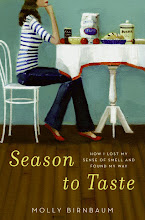My starting date at the Culinary Institute of America had been set for only months away. But without smell, I lost my ability to detect flavor in food and hence, my dream of one day becoming a chef. Devastated, I suddenly operated in a world where I could not tell if milk was fresh or sour or if my clothes were clean or not. I could no longer detect the warning signals to fire or leaking gas. And even worse, I lost my ability to read people, to summon buried memories of my childhood, to fully function in a landscape filled with rich layers of sensory perception, the one that suddenly felt blank.
The accident changed my life. It changed the way I view eating and cooking, chance and purpose and even love. Instead of culinary school, I moved to New York City. Instead of handling chicken stock and confit, I worked my way through positions at magazines and newspapers. I returned to school for a masters degree. And, slowly, all the while, I regained my sense of smell. I’m lucky. I think about that every day.
This morning I baked a cake. It’s a simple cake, a butter-rich one scented with cinnamon and orange zest, and dimpled with plums. I made the same cake last year, on this exact day. I was at a writer’s residency in upstate New York then, and in the middle of writing this book on the sense of smell, one that I was afraid I would never finish. Today, the book is with my editor. Though it won't be published until next summer, it's practically complete. I’m proud of it, this project that has taught me more about perception, science and writing—and, well, about myself—than I knew was possible. Last year the cake, as I wrote, filled the kitchen with a sweet, warm scent—one of “fruit and caramel and autumn.” Today it did the same.
I didn’t purposefully bake the same cake on the same day two years in a row. At least not consciously. But I suppose it makes sense. This is a simple, easy cake. If I’ve learned anything over the last five years, it’s that these simple things mean the most: the bouquet of flowers picked from my mother’s garden or the sunset on an evening walk with Matt, a bite of homemade vanilla bean ice cream or the sizzle of the grill on a summer night. The deep purple, nutty brown scent of a plum cake here, now, today.

Dimply Plum Cake
Adapted from Dorie Greenspan
1 ½ cups all-purpose flour
2 teaspoons baking powder
¼ teaspoon salt
¼ teaspoon cinnamon
5 tablespoons unsalted butter, room temperature
¾ cup light brown sugar, packed
2 large eggs
1/3 cup flavorless oil, like canola or sunflower (confession: I used olive oil)
Zest of 1 orange, grated
1 ½ teaspoons vanilla extract
8 purple or red plums, halved and pitted (I used only 4, perhaps they were large)
Preheat the oven to 350 degrees Fahrenheit. Butter an 8-inch square (or round) baking pan, and dust the inside with flour. Tap out the excess and place pan on baking sheet.
Whisk together the flour, baking powder, salt and cinnamon.
Working with a mixer, beat the butter at medium speed until soft and creamy, about 3 minutes. Then, add the sugar and beat for another 3. Add the eggs, one at a time, beating for a minute after each. Then, beat in the oil, zest and vanilla. The batter will be smooth and creamy. Reduce mixer speed and add the dry ingredients, mixing until incorporated.
Scrape batter into pan and smooth the top. Arrange the plums cut side up in the batter, jiggling them a tad so that they settle in.
Bake for 40 minutes, or until the top is golden brown and puffed. Transfer to a rack and cool for 15 minutes. Then, run a knife around edge and unmold. Invert and cool right side up.
You can wrap the cake once it has cooled and keep it at room temperature for a couple of days. It will get softer and with more moisture. I highly recommend this. Also, I highly recommend serving it with a fat dollop of whipped cream.






























